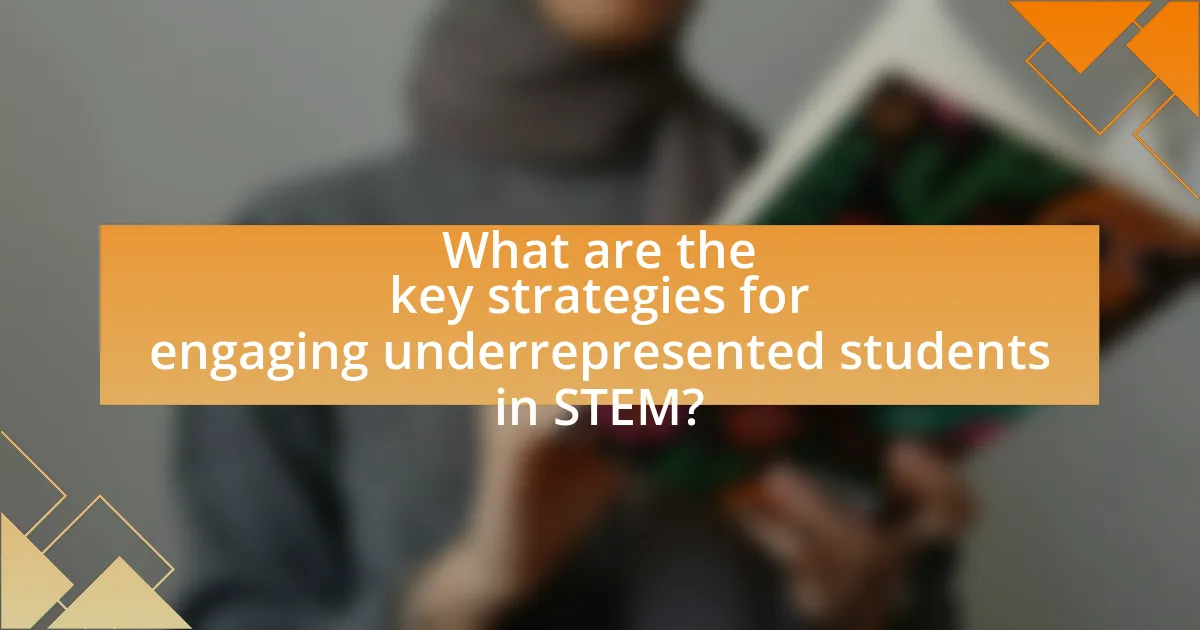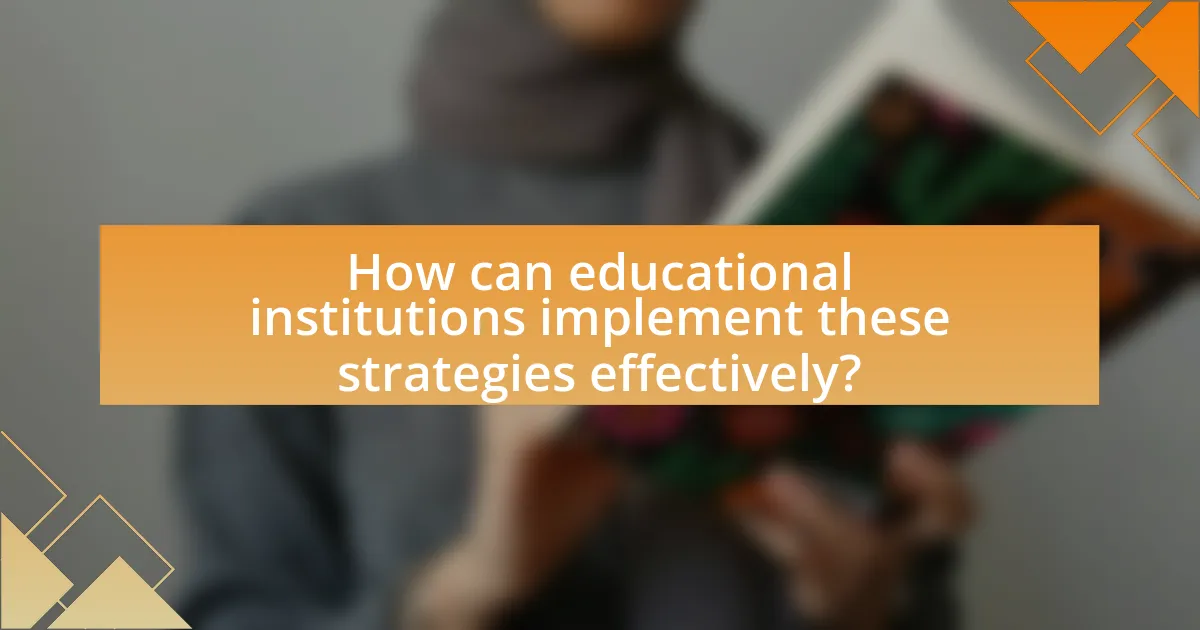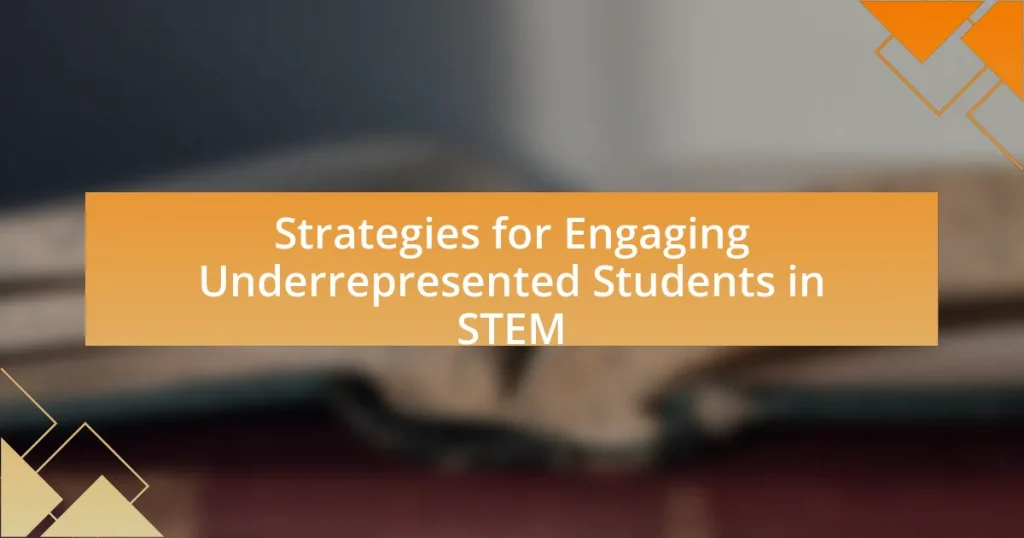The article focuses on strategies for engaging underrepresented students in STEM fields, emphasizing the importance of creating inclusive learning environments, providing mentorship opportunities, and integrating culturally relevant curricula. It outlines the unique challenges these students face, such as lack of access to resources and systemic biases, and discusses how tailored support systems can enhance their engagement and retention. Additionally, the article highlights the role of mentorship and role models in fostering confidence and interest in STEM careers, while also detailing best practices for developing inclusive curricula and the impact of community partnerships on student success. Measurable outcomes of these engagement strategies, including improved academic performance and retention rates, are also examined.

What are the key strategies for engaging underrepresented students in STEM?
Key strategies for engaging underrepresented students in STEM include creating inclusive learning environments, providing mentorship opportunities, and integrating culturally relevant curricula. Inclusive learning environments foster a sense of belonging, which research shows is crucial for student retention; for instance, a study by the National Science Foundation found that students who feel included are more likely to persist in STEM fields. Mentorship opportunities connect students with role models who share similar backgrounds, enhancing their confidence and interest in STEM careers; data from the American Society for Engineering Education indicates that mentorship significantly improves academic performance and career aspirations among underrepresented groups. Lastly, culturally relevant curricula that reflect the diverse experiences of students can increase engagement and motivation, as evidenced by research published in the Journal of Engineering Education, which highlights that students are more likely to engage with material that resonates with their personal experiences.
How do these strategies address the unique challenges faced by underrepresented students?
These strategies address the unique challenges faced by underrepresented students by providing tailored support systems that enhance accessibility and engagement in STEM fields. For instance, mentorship programs connect students with role models who share similar backgrounds, fostering a sense of belonging and motivation. Additionally, culturally relevant curricula and teaching methods help to bridge gaps in understanding and relevance, making STEM subjects more relatable. Research indicates that underrepresented students often face barriers such as lack of representation and resources; thus, initiatives like scholarships and targeted outreach programs directly mitigate these obstacles by increasing financial support and awareness of opportunities in STEM.
What specific barriers do underrepresented students encounter in STEM fields?
Underrepresented students encounter several specific barriers in STEM fields, including lack of access to resources, insufficient mentorship, and systemic biases. Research indicates that these students often attend schools with fewer advanced STEM courses and limited access to technology, which hinders their preparation for higher education in these areas. Additionally, the absence of role models and mentors from similar backgrounds can lead to feelings of isolation and decreased motivation. Systemic biases, such as stereotypes and discrimination, further exacerbate these challenges, creating an environment that can discourage participation in STEM. For instance, a study by the National Science Foundation found that underrepresented minorities are significantly less likely to pursue STEM degrees compared to their peers, highlighting the impact of these barriers on educational outcomes.
How can understanding these barriers inform effective engagement strategies?
Understanding barriers faced by underrepresented students in STEM can inform effective engagement strategies by allowing educators and institutions to tailor their approaches to address specific challenges. For instance, recognizing that financial constraints limit access to resources enables the development of targeted scholarships and funding opportunities. Additionally, understanding cultural and social barriers can lead to the creation of inclusive environments that foster belonging and support. Research indicates that programs designed with these insights, such as mentorship initiatives and community-building activities, significantly improve participation rates among underrepresented groups in STEM fields.
What role do mentorship and role models play in these strategies?
Mentorship and role models are crucial in strategies for engaging underrepresented students in STEM as they provide guidance, support, and inspiration. Mentors help students navigate academic and career pathways, fostering confidence and resilience. Research indicates that students with mentors are more likely to pursue STEM careers, as they benefit from personalized advice and networking opportunities. For instance, a study by the National Mentoring Partnership found that mentored youth are 55% more likely to enroll in college and 78% more likely to volunteer regularly in their communities, demonstrating the significant impact of mentorship on educational outcomes. Role models, particularly those from similar backgrounds, enhance relatability and motivation, showing students that success in STEM fields is attainable.
How can mentorship programs be designed to support underrepresented students?
Mentorship programs can be designed to support underrepresented students by incorporating culturally responsive practices and tailored resources. These programs should match mentors with mentees based on shared backgrounds or experiences, fostering a sense of belonging and understanding. Research indicates that mentorship relationships significantly enhance academic performance and retention rates among underrepresented groups; for instance, a study by the National Mentoring Partnership found that mentored students are 55% more likely to enroll in college and 78% more likely to hold leadership positions. Additionally, providing training for mentors on the unique challenges faced by underrepresented students can improve the effectiveness of these programs, ensuring that mentors are equipped to offer relevant guidance and support.
What impact do role models have on students’ perceptions of STEM careers?
Role models significantly influence students’ perceptions of STEM careers by providing relatable examples of success and demonstrating the possibilities within these fields. Research indicates that when students see individuals who share similar backgrounds or experiences succeeding in STEM, they are more likely to envision themselves in those roles. For instance, a study published in the Journal of Educational Psychology found that students exposed to role models in STEM reported increased interest and self-efficacy in pursuing related careers. This effect is particularly pronounced among underrepresented groups, as role models can help mitigate feelings of isolation and self-doubt, thereby fostering a more inclusive environment that encourages diverse participation in STEM fields.

How can educational institutions implement these strategies effectively?
Educational institutions can implement strategies for engaging underrepresented students in STEM effectively by fostering inclusive environments, providing mentorship programs, and integrating culturally relevant curricula. Creating inclusive environments involves training faculty and staff on diversity and inclusion, which has been shown to improve student retention rates among underrepresented groups. Mentorship programs that connect students with professionals in STEM fields can enhance students’ sense of belonging and provide networking opportunities, as evidenced by studies indicating that mentorship significantly boosts academic performance and career aspirations. Additionally, integrating culturally relevant curricula that reflect the backgrounds and experiences of diverse students can increase engagement and motivation, supported by research demonstrating that students perform better when they see their identities represented in their education.
What are the best practices for creating inclusive STEM curricula?
The best practices for creating inclusive STEM curricula involve integrating diverse perspectives, employing culturally relevant pedagogy, and ensuring accessibility for all students. Incorporating diverse perspectives means including contributions from various cultures and backgrounds in STEM content, which can enhance engagement and relevance for underrepresented students. Culturally relevant pedagogy emphasizes teaching methods that connect with students’ cultural contexts, fostering a sense of belonging and motivation. Ensuring accessibility involves designing curricula that accommodate different learning styles and needs, such as providing materials in multiple formats and offering varied assessment methods. Research shows that inclusive curricula can lead to improved academic outcomes and increased interest in STEM fields among underrepresented groups, as evidenced by studies from the National Science Foundation highlighting the positive impact of inclusive practices on student retention and success in STEM disciplines.
How can curricula be adapted to reflect diverse perspectives in STEM?
Curricula can be adapted to reflect diverse perspectives in STEM by integrating culturally relevant content and inclusive teaching practices. This approach involves incorporating examples, case studies, and contributions from underrepresented groups in STEM fields, which can enhance engagement and relatability for diverse student populations. Research indicates that when curricula include diverse perspectives, such as those from women, minorities, and indigenous communities, it not only fosters a sense of belonging but also improves academic performance and retention rates among these students. For instance, a study published in the Journal of Engineering Education found that students exposed to diverse role models in engineering courses demonstrated increased interest and persistence in the field.
What resources are available to support the development of inclusive curricula?
Resources available to support the development of inclusive curricula include organizations, toolkits, and research studies focused on diversity in education. For instance, the National Science Foundation provides funding and resources aimed at enhancing diversity in STEM education. Additionally, the “Inclusive STEM Teaching Project” offers a comprehensive toolkit that includes strategies and practices for creating inclusive learning environments. Research by the American Association of Colleges and Universities highlights the importance of inclusive pedagogy in improving student engagement and success among underrepresented groups. These resources collectively contribute to the effective development of curricula that cater to diverse student needs in STEM fields.
How can community partnerships enhance engagement efforts?
Community partnerships can enhance engagement efforts by providing resources, expertise, and networks that facilitate outreach and support for underrepresented students in STEM. These collaborations enable educational institutions to leverage local organizations’ knowledge and connections, which can lead to tailored programs that resonate with the community’s specific needs. For instance, partnerships with local businesses can offer mentorship opportunities, internships, and real-world experiences that make STEM fields more accessible and appealing. Research indicates that students involved in community-based programs are more likely to persist in STEM education, as evidenced by a study published in the Journal of STEM Education, which found that such initiatives increased student retention rates by 20%.
What types of community organizations can collaborate with educational institutions?
Community organizations that can collaborate with educational institutions include non-profits focused on youth development, local businesses offering internships, cultural organizations promoting diversity, and advocacy groups addressing educational equity. These organizations often provide resources, mentorship, and programs that enhance STEM education for underrepresented students. For instance, partnerships with local non-profits can facilitate after-school programs that focus on STEM skills, while cultural organizations can help create inclusive curricula that reflect diverse perspectives. Such collaborations have been shown to improve student engagement and success in STEM fields, as evidenced by initiatives like the National Science Foundation’s partnerships with community organizations to increase participation among underrepresented groups.
How can partnerships be structured to maximize impact on underrepresented students?
Partnerships can be structured to maximize impact on underrepresented students by aligning resources, expertise, and support systems among educational institutions, community organizations, and industry stakeholders. Collaborative initiatives that focus on mentorship, internships, and tailored educational programs have been shown to enhance engagement and retention rates among these students. For instance, programs like the National Science Foundation’s STEM Talent Expansion Program have successfully increased participation of underrepresented groups in STEM fields by fostering partnerships that provide hands-on experiences and academic support. These structured collaborations create pathways that address barriers to entry and promote a more inclusive educational environment.

What are the measurable outcomes of engaging underrepresented students in STEM?
Engaging underrepresented students in STEM leads to measurable outcomes such as increased academic performance, higher retention rates, and improved graduation rates. Research indicates that programs specifically designed for these students can enhance their understanding of STEM subjects, with studies showing that participants often achieve grades that are 10-20% higher than their peers. Additionally, initiatives that provide mentorship and hands-on experiences have been linked to a 30% increase in retention rates among underrepresented groups in STEM fields. Furthermore, data from the National Science Foundation reveals that underrepresented students who engage in STEM programs are 50% more likely to graduate with a degree in a STEM discipline compared to those who do not participate in such programs.
How can success be defined and measured in these engagement strategies?
Success in engagement strategies for underrepresented students in STEM can be defined and measured through specific metrics such as increased enrollment, retention rates, and academic performance. For instance, a successful strategy may be indicated by a 20% increase in enrollment of underrepresented students in STEM programs over a three-year period, as reported by the National Science Foundation. Additionally, retention rates can serve as a key indicator; a program that maintains at least 75% of its participants through graduation demonstrates effective engagement. Academic performance, measured through GPA improvements or standardized test scores, further quantifies success, with studies showing that targeted mentorship can lead to a 15% increase in GPA among participants. These metrics provide concrete evidence of the effectiveness of engagement strategies in fostering success among underrepresented students in STEM fields.
What metrics can be used to assess student participation and achievement in STEM?
Metrics used to assess student participation and achievement in STEM include enrollment rates, attendance records, assessment scores, project completion rates, and participation in extracurricular STEM activities. Enrollment rates indicate the number of students engaged in STEM courses, while attendance records reflect their commitment. Assessment scores, such as standardized tests or project evaluations, measure academic achievement. Project completion rates provide insight into students’ ability to apply STEM concepts, and participation in extracurricular activities highlights engagement beyond the classroom. These metrics collectively offer a comprehensive view of student involvement and success in STEM fields.
How can feedback from students inform the continuous improvement of engagement strategies?
Feedback from students can significantly inform the continuous improvement of engagement strategies by providing direct insights into their experiences and preferences. When students share their thoughts on teaching methods, course materials, and overall engagement, educators can identify specific areas that require enhancement. For instance, a study by the National Science Foundation found that incorporating student feedback led to a 20% increase in participation among underrepresented groups in STEM programs. This data illustrates that actively seeking and implementing student feedback can lead to more effective and inclusive engagement strategies, ultimately fostering a better learning environment for all students.
What are some practical tips for educators and administrators?
Educators and administrators can enhance engagement of underrepresented students in STEM by implementing culturally relevant pedagogy, which connects learning to students’ cultural contexts. This approach has been shown to improve student motivation and academic performance, as evidenced by research from Ladson-Billings (1994) in “The Dreamkeepers: Successful Teachers of African American Children,” which highlights the effectiveness of culturally responsive teaching methods. Additionally, fostering partnerships with community organizations can provide students with mentorship opportunities and real-world STEM experiences, further increasing their interest and participation in these fields.
How can educators create a supportive classroom environment for underrepresented students?
Educators can create a supportive classroom environment for underrepresented students by implementing culturally responsive teaching practices. Culturally responsive teaching recognizes the diverse backgrounds of students and integrates their cultural references into the learning process, which has been shown to improve engagement and academic performance. Research indicates that when educators acknowledge and incorporate students’ cultural identities, it fosters a sense of belonging and enhances motivation. For instance, a study published in the “Journal of Educational Psychology” found that culturally relevant pedagogy positively impacts the academic outcomes of minority students, demonstrating the effectiveness of this approach in creating an inclusive and supportive learning environment.
What strategies can be employed to foster a sense of belonging in STEM programs?
To foster a sense of belonging in STEM programs, institutions can implement mentorship programs that connect students with role models in their fields. Research indicates that mentorship significantly enhances students’ academic engagement and retention, particularly among underrepresented groups. For instance, a study published in the Journal of STEM Education found that students who participated in mentorship initiatives reported higher levels of belonging and academic success. Additionally, creating inclusive learning environments through collaborative projects and diverse team compositions can further enhance students’ sense of belonging, as evidenced by findings from the National Science Foundation, which highlight the positive impact of teamwork on student engagement in STEM disciplines.



